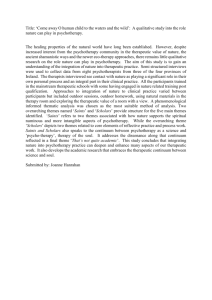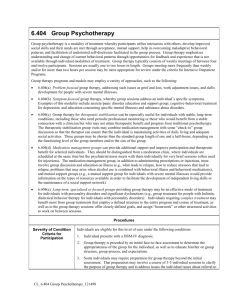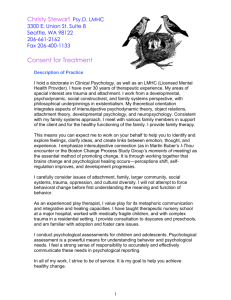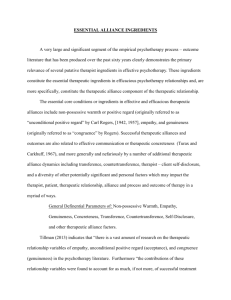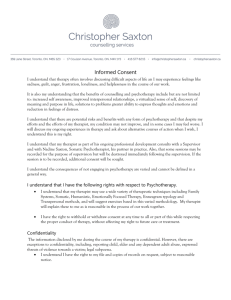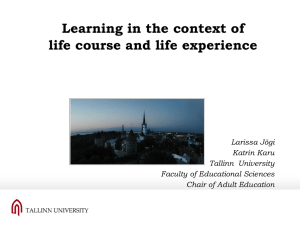Arany Zoltán – Dr - 2nd WORLD CONGRESS OF ARTS THERAPIES
advertisement
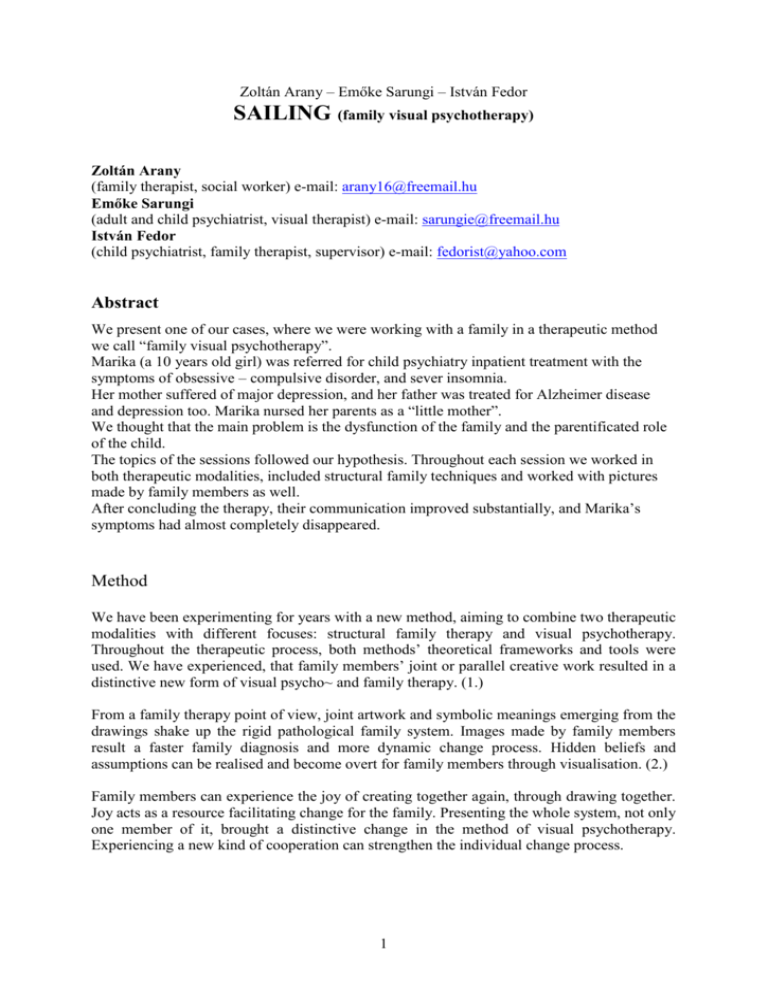
Zoltán Arany – Emőke Sarungi – István Fedor SAILING (family visual psychotherapy) Zoltán Arany (family therapist, social worker) e-mail: arany16@freemail.hu Emőke Sarungi (adult and child psychiatrist, visual therapist) e-mail: sarungie@freemail.hu István Fedor (child psychiatrist, family therapist, supervisor) e-mail: fedorist@yahoo.com Abstract We present one of our cases, where we were working with a family in a therapeutic method we call “family visual psychotherapy”. Marika (a 10 years old girl) was referred for child psychiatry inpatient treatment with the symptoms of obsessive – compulsive disorder, and sever insomnia. Her mother suffered of major depression, and her father was treated for Alzheimer disease and depression too. Marika nursed her parents as a “little mother”. We thought that the main problem is the dysfunction of the family and the parentificated role of the child. The topics of the sessions followed our hypothesis. Throughout each session we worked in both therapeutic modalities, included structural family techniques and worked with pictures made by family members as well. After concluding the therapy, their communication improved substantially, and Marika’s symptoms had almost completely disappeared. Method We have been experimenting for years with a new method, aiming to combine two therapeutic modalities with different focuses: structural family therapy and visual psychotherapy. Throughout the therapeutic process, both methods’ theoretical frameworks and tools were used. We have experienced, that family members’ joint or parallel creative work resulted in a distinctive new form of visual psycho~ and family therapy. (1.) From a family therapy point of view, joint artwork and symbolic meanings emerging from the drawings shake up the rigid pathological family system. Images made by family members result a faster family diagnosis and more dynamic change process. Hidden beliefs and assumptions can be realised and become overt for family members through visualisation. (2.) Family members can experience the joy of creating together again, through drawing together. Joy acts as a resource facilitating change for the family. Presenting the whole system, not only one member of it, brought a distinctive change in the method of visual psychotherapy. Experiencing a new kind of cooperation can strengthen the individual change process. 1 Therapeutic setting Marika, aged 10 was repeatedly hospitalised for obsessive-compulsive symptoms and suspected psychosis. Sexual abuse and depression of both parents were in history. Her father suffered from Alzheimer’s disease as well. Because of mental disorders of all family members and interactional dysfunctions of the family context, we decided to use a complex approach combining visual psychotherapy and family therapy. (Fig. 1.) Inequal sharing of tasks between parents Depression Mother Attachment Rejection Individual level: Interactional level: Family level: Father Enmeshed boundaries Compulsions limited to family context Parentification of the child Marika Alzheimer’s disease Depression Ambivalent expectations of father Phobia (touch) of Marika Sexual harrasment (by stranger) Phobic-obsessive symptomatology Figure 1. 3 level diagnosis Therapeutic process The parents’ limited emotional and physical capacity put a weight that overwhelmed Marika’s emotional and physical abilities. During initial sessions Marika presented her parentificated role in her drawings (Session 3, Picture 3.) Regressive elements appearing in her drawings refer to her desire to become a child again. The secure field of therapy helped her to express her desires. (3.) After this session (No.3.) 2 couple therapy sessions were included in order to strengthen the parental subsystem. In the joint drawings of the last 2 sessions water as an element and a ship appeared again, both were present on their introductory picture as well. Family travelled on the Sea of Emotions from a dark coast to a peaceful island in one ship together this time.(4.) 2 In the last picture, “Present” they drew about a family game, where joint, joyful experience became part of their everyday life, can be a cohesive force for them. It was striking to see, that the pictures of Marika, especially one entitled “Presenting the Evil” (Fig. 3.) provoked string emotions in parents even without interpretation. They understood without verbal expression, confrontation, interpretation, and working through resistance, how Marika feels herself in the family.(3.) This coming to terms helped them to search for new resources in their relationship, despite of their instable mental balance and variable endurance. This made possible for the parents to provide emotional safety for their child. Shared problem, common future, joint effort as appeared in the picture entitled “Family vision” (Fig. 6.) contributed to this process. The ship – powered by 2 paddles (parents) – also has a motor, which they called the “power of family”. According to the father they have a sail just in case if the power of the motor would decrease and they should trust the forces of nature. Process in pictures Family therapy Psychodinamics -pictures Therapeutic process Session I Dysfunctional family boundaries - rigid inside - loose outside (many people on the picture, who are not family members) Homework: paradox instruction 3x30 min/week M. measuring time The aim was to bring parental conflict to surface, where M’s task to substitute the symptom. Measuring time has regulatory function. Introduction of family (drawn together) Figure 1. Water bounding an ideal from a fantastic family Father draws, M. controls „Everybody is in his/her own ship, with his/her own diseases” 3 Family therapy Psychodinamics -pictures Therapeutic process Session II Shared past as resource (shift in perspective) Introduction of Good (drawn together) Absence of family Figure 2. feasts in the present Hw: „Setting boundaries” – Present for the parents: a dinner together, M sleeps at a girlfriend Regressive elements in M’s drawing and behaviour Session III Reordering of subsystems continues Emerging parental conflicts Naming that no standard practice in parenting exists Introduction of Evil (without instructions) Contracting: Improving communication Marika’s parentification appears on her own picture Parents gained insight the position of M. in the family, and her emotions related to this M’s drawing style and behaviour on the session showed regressive elements Parents draw a picture together with 2 problem focus Marika’s drawing (Figure 3.) Parents drew about decline and death Couple therapy sessions were included in order to strengthen parental subsystem 4 Family therapy Psychodinamics -pictures Therapeutic process Session IV – VI (Couple therapy) Shared past as resource Hw: Paradox instruction Intimacy without sex IV: Dating (Figure 4.) Regression of couple until getting married ”Forming a couple” they tear them apart from the mass of people Solemnity highlighting the strength of their relationship Parental subsystem, rebuilding couple relations Birth of family as a unit , setting boundaries of subsystems Separation as a need presented by the parents V: Change (Figure 5.) VI: Family vision (Figure 6.) 5 Couple as emotional, sexual unit introduce itself Gentle and moderated presentation of intimacy From a dark coast to a peaceful island, they sail across the “Sea of Emotions”, created symbolically by the water, in one ship Family therapy Psychodinamics -pictures Therapeutic process Session VII Restructuring of the family system Present (Figure 7.) Realistic image of family, acceptable, but not perfect Joint joyful experience present in everyday reality Summary During therapeutic process (3 months) Marika gradually became symptom less, and the family system transformed substantially. Family subsystems were reorganised. (4.) Marika got back to child subsystem again. One year after the end of therapy we had a follow up. The subsystems kept their boundaries. Marika stayed symptom less. They still had difficulties, because father’s condition gradually deteriorates. It seemed that the family could overcome their difficulties. During therapeutic sessions therapists made decisions which approach were used in the actual situation. In this course family therapist was less directive and visual therapist did not interpret at all. Combining visual psychotherapy and family therapy gives new qualities to both. For structural family therapy images help to understand the system easier, to reorganise the pathological dysfunctions more dynamically. For visual psychotherapy, it gives opportunity to work through individual problems and in the meantime family reorganise itself. Primary profit for the family, that the combination is especially change-oriented, working through a lot of resistance with the help of pictures. In summary we can state, that combining family therapy and visual psychotherapy makes more effective, changes occur more rapidly, therefore we recommend it for your consideration. References: 1. Vizuális Psichoterápia . szerk: Vera Vasarhelyi/ Animula, Bp.1996 (6-11old.) 2. Böszörményi-Nagy Iván, Barbara R. Krasner: Kapcsolatok kiegyensúlyozásának dialógusa / Coincidencia, Bp. 2001 (205, 303 old.) 3. Thessa Daelly: Images of Art Therapy / Rautledge, London-New York 1992. (68-70, 159-161 old.) 4. Családterápiás Olvasókönyv I. / Animula, Bp. 1990. (20-27 old.) 6

